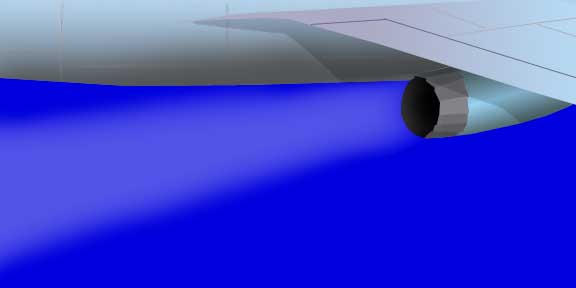|
Vapour Trails |
 |
| FTLComm - Tisdale - February 23, 2001 |
| Gerald Crawford's question about the clarity of vapour trails is an interesting one
and when we realise what is going on we can actually get some valuable information
from what we see. The nature of the turbojet engine is what makes this whole phenomena intriguing. A piston powered aircraft also leaves vapour trails when it flies in very cold air or a high altitude which is also very cold. However, the piston engine burns gasoline and most such engines are only turbo charged so that though the exhaust is fairly high in water vapour it is not really as complete a combustion process as the jet. the front end of a jet engine consists of a massive turbine which acts as a compressor. Modern aircraft engine obtain so much of their efficiency by utilising this front compressor to blow as much as 60% of its capacity right by the engine (high by-pass) but the net result is that the kerosene fuel that is injected into the burning chamber has vast amounts of oxygen to burn and the efficiency of these engines is remarkably high. This efficiency means that most of the kerosene (JP4) is converted to hot water vapour as it accelerates the heated air out through the hot section of the back end of the engine providing the thrust to propel the aircraft forward. These aircraft normally fly at above 30,000 feet where the air is always (year round) ultra cold and very thin. The thin air reduces the amount of resistance to the aircraft moving through it and the engine's large compressor is able to compact that thin air sufficiently to get optimum combustion conditions. The difference from Canadian air and that which one would see over Utah and Arizona is considerable. The air over Canada, year round is substantially colder. The water vapour coming out of the aircraft's exhaust hits the cold air and condenses forming visible ice crystals and appears to us as a trail in the sky. The exhaust is about the same temperature no matter where the aircraft is flying so in the warmer atmosphere over the American South that expanding hot gas moves outward and condenses into its distinct vapour trail simply because a smaller amount of it is turning into a visible trail. However, over Canada the air is very very cold and the vapour trail is much denser and forms much closer to the engine exhaust producing a dense cloud. The nature of expanding gases is that they will move outward and hence the vapour trails over Canada tend to merge and be substantially larger. To test this take you binoculars and observe the nightly flight from LAX that passes over the Tisdale area around 5:30 each day on its way to London. Usually this is a Boeing 747 with four huge turbo jet engines pumping out massive amounts of water vapour. With your binoculars you will see that right behind the aircraft the trails are distinct and separate from one another but as you move back from the aircraft's tail they soon merge as they quickly spread out to almost half a kilometre in width. Were you to observe with your binoculars a similar flight over Las Vegas you would discover that the trails is thinner to start with and as it spreads outward it begins to dissipate very quickly with only the central part of the trail remaining visible thus showing the distinct engine trails rather then a single merged trail. When you look up and spot a high flying aircraft leaving almost not or a very small vapour trail you realise that the air it is flying in is warmer and warm winds aloft will soon result in warmer temperatures on the surface, Warm winds aloft will also indicate unsettled weather and the possibility of storms. |